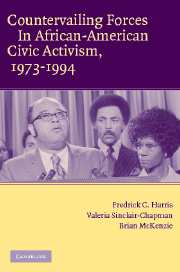Book contents
- Frontmatter
- Contents
- List of Figures and Tables
- Acknowledgments
- 1 Introduction
- 2 Good Times and Bad: Trends in the Economic, Social, and Political Conditions of African Americans in the Post–Civil Rights Era
- 3 Studying Group Activism: Toward a Macro Approach to Black Civic Participation
- 4 Echoes of Black Civic Activism: Historical Foundations and Longitudinal Considerations
- 5 Shifting Forces: Modeling Changes in Post–Civil Rights Black Activism
- 6 From Margin to Center: Bringing Structural Forces into Focus in the Analysis of Black Activism
- Appendix A Question Wording and Coding
- Appendix B Variable Sources and Descriptions
- Appendix C Time Series Models
- References
- Index
5 - Shifting Forces: Modeling Changes in Post–Civil Rights Black Activism
Published online by Cambridge University Press: 15 December 2009
- Frontmatter
- Contents
- List of Figures and Tables
- Acknowledgments
- 1 Introduction
- 2 Good Times and Bad: Trends in the Economic, Social, and Political Conditions of African Americans in the Post–Civil Rights Era
- 3 Studying Group Activism: Toward a Macro Approach to Black Civic Participation
- 4 Echoes of Black Civic Activism: Historical Foundations and Longitudinal Considerations
- 5 Shifting Forces: Modeling Changes in Post–Civil Rights Black Activism
- 6 From Margin to Center: Bringing Structural Forces into Focus in the Analysis of Black Activism
- Appendix A Question Wording and Coding
- Appendix B Variable Sources and Descriptions
- Appendix C Time Series Models
- References
- Index
Summary
If we are serious, the black politics of Gary must accept major responsibility for creating both the atmosphere and program for fundamental, far ranging change in America.
Activist, National Black Political Convention, 1972The new civil rights movement must reframe its strategy around combating civil death, pushing for meaningful, winnable reforms that increase the civic capacities of oppressed people, permitting them to assume greater roles in determining society's future.
Manning Marable, The Great Wells of Democracy, 2002In the previous chapter, we argued that the macro-level forces of empowerment and distress act as counterweights to each other, pulling black activism upward or pushing it downward as social, economic, and political opportunities were created by some factors and constrained by others. We also presented the historical and methodological rationale for the modeling choices we make in our analysis of post–civil rights black activism. In this chapter, we use statistical models to examine how well these sets of factors explain changes in aggregate levels of black activism from 1973 and 1994. The first part of the chapter describes trends in civic activism for blacks as a group, by region, and by gender. We then present the results of our GLS models of composite participation, political work, and organizational work, which show consistent evidence of a tug-of-war between black political empowerment on the one hand and social and economic distress on the other.
- Type
- Chapter
- Information
- Publisher: Cambridge University PressPrint publication year: 2005



